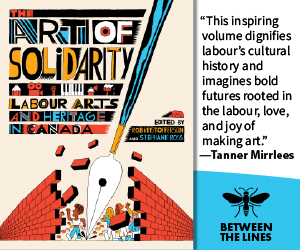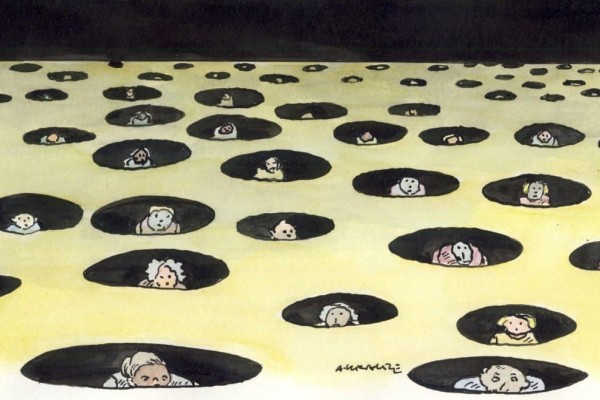Canada Steel
(Warning: This theatre may give you calluses)
Every street in every old Canadian industrial town has its own Gus Popadopolous. He’s the old timer on your block that stuck around when the abandoned factory morphed into gentrified condos. His mode of dress is a white undershirt, no matter what the weather. His all-purpose accoutrement is a shovel, not a cell phone. He might cheer you on at road hockey, but wouldn’t hesitate to yell at you if the ball went into his garden. You know him. You might even be him!
The story of the decline and fall of Gus and Canada’s working class was brought to life this past February in Canada Steel, the second installment of the Canada House trilogy by playwright J. Karol Korczynski and the Canada House Artistic Theatre Cooperative.
After the closure of the Canada Steel plant, the Popadopolous family of Hamilton begins to implode under the pressures of the new world order: rampant globalization, industrial decline and corporate trade unionism. Gus, a laid-off steelworker, spends long stretches on hold with a South Asian call centre trying to sort out his benefits package, as a looping voicemail message insists, “your call is important to us.” During the demolition of the old plant, his wife Rose finds a valuable, long-lost Diego Rivera-esque painting, which a crooked union rep tries to swindle from her. Their daughter Roxie toils away at Tim Hortons, helping her family survive on meagre wages and pilfered conference-centre buffet food. Bhopal, the offshore help-line worker assigned to Gus’ case, finds that her job is also on the line when her employer relocates the call centre to Burma. The only person succeeding in spite of all of this is Les, a high-rolling labour executive who moves up the ranks by co-opting his union and its principles for personal gain. The workers of this world are in trouble, and it’s unlikely they will ever find redemption. Not in this universe.
“The inspiration for Canada Steel was a real guy,” Korczynski told me after a matinee performance at the Tarragon Extra Space in Toronto. “I worked in the 1980s in the Rust Belt, and I knew a Pittsburgh steelworker. His factory closed and he was living in a rooming house. He had lost his family and was in very bad shape. I saw him years later at an anti-war conference in Michigan, and there he was with a giant painting he had found in the steel mill, and was trying to get it shown. The passion and joy in his face was so remarkable that I said I’ve got to write about this.”
Korczynski’s own passion, which is to tell the stories of working people, is evident throughout his writing. Originally from Sarnia, Ontario, he has traveled the world while working in myriad professions. “I’ve moved around just working, whether it be construction, factory work, hotel and night-shift watchman work. Whatever went is what I would do, and I kept my eyes and ears open.” It is this blue-collar sensibility that breathes life into Korczynski’s plays. His intensely realistic characters seem as if at any moment they might walk off the stage and into your life. The audience takes part in a bona fide reality-T.V. show – without the ridiculous scenarios, vapid personalities and corporate placements. It’s light years away from the frou-frou, $400-a-seat shows of Toronto’s King Street. You might leave with calluses.
Theatre and Universal Values
The Canada House Artistic Cooperative evolved out of what was intended to be a one-time show in 2005, the critically acclaimed Canada House. The initial project came into being after long-time Shaw Festival stalwart Wendy Thatcher read some of Korczynski’s short stories, and asked him if he would write something for her – the result of which was the original Canada House. This first play has recently been published in Three on the Boards, the new Canadian theatre anthology, stirring up Canada-wide interest in Korczynski’s work outside of Toronto. The group’s ultimate aim is to create theatre that respects the socially critical traditions of the great twentieth-century critics.
Their influences are a who’s who of independent theatre notables, like left-leaning playwrights George Bernard Shaw and Bertolt Brecht, along with Clifford Odets and the Group Theater of 1930s New York, and Dario Fo’s Italian theatrical collectives. These writers and their theatre companies challenged the social-political situations of their times and encouraged audiences to examine the issues of the day, rather than settling for passive escapism. The cooperative is continuing this tradition in earnest.
“You want to be able as a writer to embrace universal truths,” Korczynski said, when asked of the socialist ethos evident in his work. “When you’re dealing with political topics, the big challenge is to embrace universal values as much as possible without losing your social and political message.” It is this approach that makes the Canada House series accessible; it’s critical, yet carries a wide appeal, reaching out to people who might not be typical theatre patrons. All are welcome.
The trilogy’s initial run will wrap up in 2009, when the final installment, Canada Square, hits the stage. This story will follow the financial catastrophe of a wealthy Rosedale couple whose investments go awry, leading them to take up residence in a junior bachelor apartment at Yonge and Eglinton, an area of Toronto known as Canada Square. It will undoubtedly be a product of the motto that J. Karol Korczynski and the Canada House Artistic Cooperative live by: “We live in dangerous times. Theatre once again must become dangerous!” If you think you might like intelligent, thought-provoking, accessible theatre, then Canada Square will be a must-see for you.
You should probably take Gus with you.
This article appeared in the May/June 2008 issue of Canadian Dimension (May Day!).










